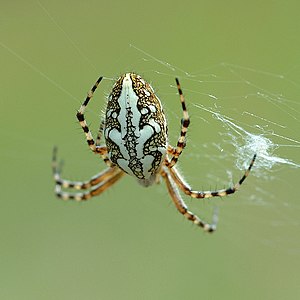Oak leaf wheel spider
| Oak leaf wheel spider | ||||||||||||
|---|---|---|---|---|---|---|---|---|---|---|---|---|

Oak leaf wheel spider ( Aculepeira ceropegia ), female |
||||||||||||
| Systematics | ||||||||||||
|
||||||||||||
| Scientific name | ||||||||||||
| Aculepeira ceropegia | ||||||||||||
| ( Walckenaer , 1802) |
The oak leaf wheel spider or oak leaf cross spider ( Aculepeira ceropegia , syn .: Araneus ceropegia ) is a species of spider from the family of real orb web spiders (Araneidae). Thanks to its eponymous, striking drawing, the species is relatively easy to identify. It is widespread and quite common in Central Europe.
description
The females grow to an average of 12-14 mm, the males 7-8 mm. The front part of the body ( prosoma ) is quite a monochrome dark brown and only clearly lightened towards the eyes. However, this basic color is usually barely recognizable due to the strong, white hair. The rear body ( opisthosoma ) is relatively high, quite narrow and clearly pointed towards the rear. On a yellowish-brown background it shows a fine, dark network drawing and on the middle of the back a very conspicuous, white longitudinal band, which is strongly bulged in several places and becomes narrower towards the back. It is vaguely reminiscent of the leaf of an English oak or a sessile oak . The thighs ( femur ) are monochrome brown, the outer leg links are narrowly curled light-dark.
distribution and habitat
The species colonizes almost all of Europe, but it is much rarer in the northwest and is absent in Great Britain, Ireland and Denmark. It inhabits open, sunny areas of all kinds, especially dry grass, fallow land and wet meadows, but also forest clearings. The oak leaf wheel spider is also common in the low mountain ranges and occurs in the Alps up to an altitude of around 2500 m.
Way of life
The net is built near the ground between shrubs or stalks of grain. The net hub is covered with a tightly woven, white web. The seat guard is usually near the upper edge of the net on parts of plants in a bowl-shaped web that is open at the top. The spider is very noticeable on dry parts of the plant, but it also chooses larger flowers for the installation of the hiding place, where it is less noticeable. The spider can immediately fall to the ground in the event of minor disturbances, in order to later climb back into the hiding place on its security thread.
Systematics
Since the morphology of the sexual organs differs significantly from representatives of the genus of the cross spiders ( Araneus ), this species originally assigned to Araneus was combined in a separate genus with the Aculepeira carbonaria, which is common in the Alps .
Danger
The species is widespread and medium abundant in suitable habitats. In Germany it is classified as "safe" in the Red List .
literature
- Heiko Bellmann: Cosmos Atlas Arachnids of Europe. 3. Edition. Kosmos, Stuttgart 2006, ISBN 3-440-10746-9 .
- S. Heimer, W. Nentwig: Spinning Central Europe. Parey, Hamburg / Berlin 1999, ISBN 3-489-53534-0 . (Online key)
- D. Jones: The Cosmos Spider Guide. Franckh-Kosmos Verlag, Stuttgart 1996, ISBN 3-440-06141-8 .
- Ralph Platen, Bodo von Broen, Andreas Herrmann, Ulrich M. Ratschker, Peter Sacher: Total species list and red list of spiders, harvestmen and pseudoscorpions of the state of Brandenburg (Arachnida: Araneae, Opiliones, Pseudoscorpiones) with information on frequency and ecology. (= Nature conservation and landscape management in Brandenburg. 8, booklet 2 (supplement)). 1999, DNB 959628967 .
- MJ Roberts: Collins Field Guide: Spiders of Britain & Northern Europe. Ramsbury, Bath 1995, ISBN 0-00-219981-5 .
Web links
Aculepeira ceropegia in the World Spider Catalog
- Norman I. Platnick, 2006. The World Spider Catalog, Version 7.0. American Museum of Natural History.
- Eichblatt-Radspinne on www.natur-in-nrw.de

